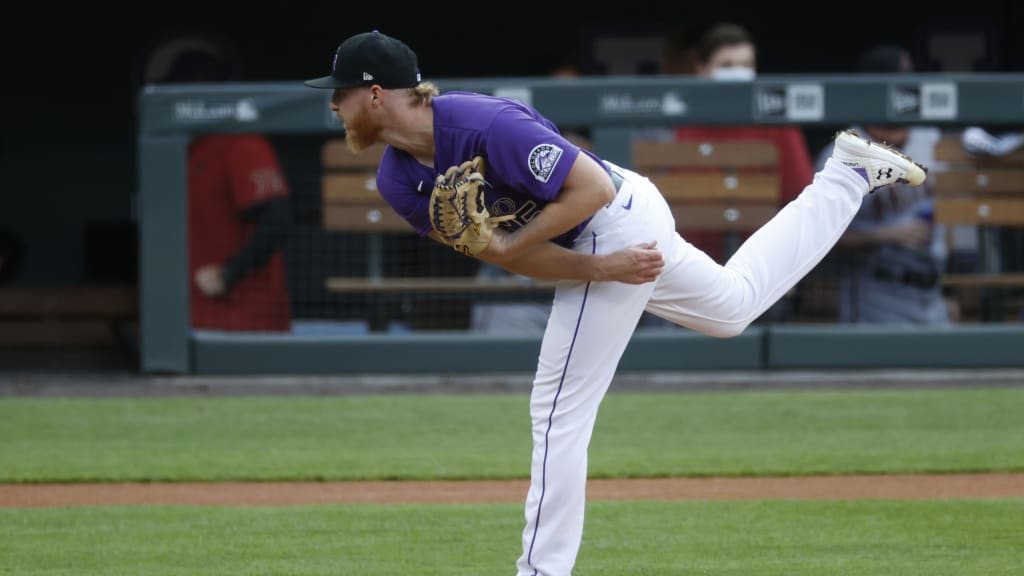
DENVER -- Rockies right-hander Jon Gray has seen a measurable drop in his four-seam fastball velocity from last year. But what isn’t clear is whether the reduction is a problem.
The heater, which Gray is throwing less often because he is changing speeds with greater regularity, is averaging 93.8 mph. Last year, he averaged 96.0 mph while posting a 3.84 ERA with 150 strikeouts in 150 innings to bounce back from an inconsistent 2018.
“I don’t have any pains or anything like that,” Gray said. “Nothing’s bothering me. It’s just I reach back [for velocity], and I look up and it’s 93, 94. It’s not normal.”
But through his first three starts, opponents didn’t do much with it. He yielded just a .143 batting average and .143 slugging percentage on 100 four-seamers. The expected batting average and expected slugging showed the contact was exactly what batters deserved.
Then the D-backs came to Coors Field, where they always hit Gray, no matter what he throws. They battered the fastball (7-for-13) on Monday night. Kole Calhoun hit the first pitch of the game for a home run, on a 92.9 mph two-seamer, in the Rockies’ 12-8 loss.
But a look at the location of the pitch shows velocity wasn’t the main problem.
“The first pitch of the game, he tried to go down and away and it was sort of in the middle,” Rockies manager Bud Black said. “A couple of hits to Nick Ahmed were fastballs up out over the plate.”
Black is far less concerned about the radar ratings than Gray.
“I think there’s a little more in there, but velocity isn’t, for me, the key factor for Jon,” Black said. “Of the three variables -- velocity, movement and location -- for Jon that’s No. 3. Location is No. 1, movement is No. 2. I just don’t think he located the fastball very well.”
There is frustration for Gray. He began with three outings that were fairly good. At Texas in the first start, he became fatigued in the fifth inning, like many pitchers do in their season debut, and his effectiveness deserted him. At home against the Padres, poor defense in the sixth inning scuttled a good outing. Then at home against the Giants, a Brandon Belt popup ended up as a three-run homer in a 4-3 defeat.
The pitching principles are there. Gray, 28, the Rockies’ most-experienced starter, has embraced increased use of his curveball for velocity separation and the changeup as a pitch to his arm side (to counterbalance pitches to his glove side).
It has been a complicated relationship with velocity for Gray. He regularly touched 100 mph at the University of Oklahoma before he was drafted third overall in 2013. Upon entering pro ball, he knew his college mechanics would not work with the frequency of outings and the quality of hitters, so he embraced a delivery that lowered velocity but increased control.
But he also wants to add pitches above the zone to his usual downward-biting stuff. A little more velocity could give him more room for error. Gray displayed frustrated body language Monday after several soft hits spoiled his night more than the first-pitch homer. With no physical issue, answers could be in mechanics, or it could be that velocity takes time -- even though there is not much of it in a 60-game regular season.
“That would be really nice, not relying on command so much,” Gray said. “I’ve been commanding my fastball really good. But obviously it’s not enough. Hopefully, I’ll get back to normal. I don’t know what I have to do to do that but it’s going to be done. It’s going to have to happen. It’s going to happen.”
He'll fix it
The Rockies trailed by one run in the seventh when shortstop Trevor Story allowed Ahmed’s hard-hit ball to bounce off his glove. Instead of a double play that would have kept Yency Almonte’s inning scoreless, Ahmed received credit for an RBI single as the D-backs scored four in the frame.
So, Story -- who committed an error in the aforementioned Gray start against the Padres -- was on the field at shortstop early Tuesday, fielding various grounders from third-base coach Stu Cole, making sure he was fundamentally sound from various body positions.
“There are a couple plays that Trevor would like to have back, for sure,” Black said. “He’s been a steady defender at a premium position for the time that I’ve been here, and he’s gotten better. I wouldn’t say he’s in any sort of fielding slump, but he has a high expectation -- as do all of us, based on what we’ve seen.
“I know in the long run Trevor is going to make way more good plays than miscues.”
Honor for longtime coach
Rockies player development and scouting special assistant Jerry Weinstein has been named 2020 recipient of the American Baseball Coaches Association/Wilson Lefty Gomez Award for contributions to the game locally, nationally and internationally. In addition to a long career at the amateur level, Weinstein has worked for the Rockies since 2007 and managed Team Israel in the 2017 World Baseball Classic.
Additionally, Weinstein’s Twitter and Facebook presences provide a sounding board for deep baseball discussion and situational instruction, and his books include the "Baseball Coach's Survival Guide" with Tom Alston and "The Complete Handbook of Coaching Catchers," as well as a coaching manual for USA Baseball.
